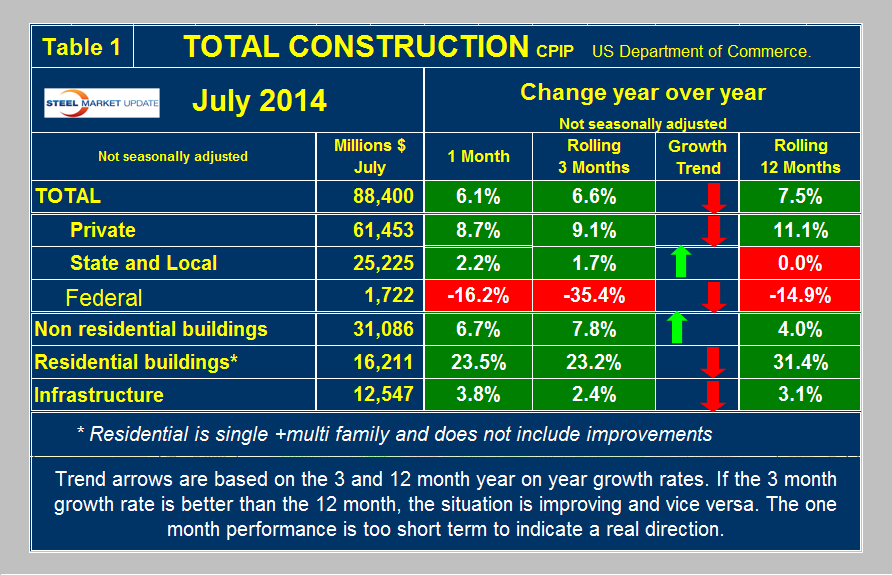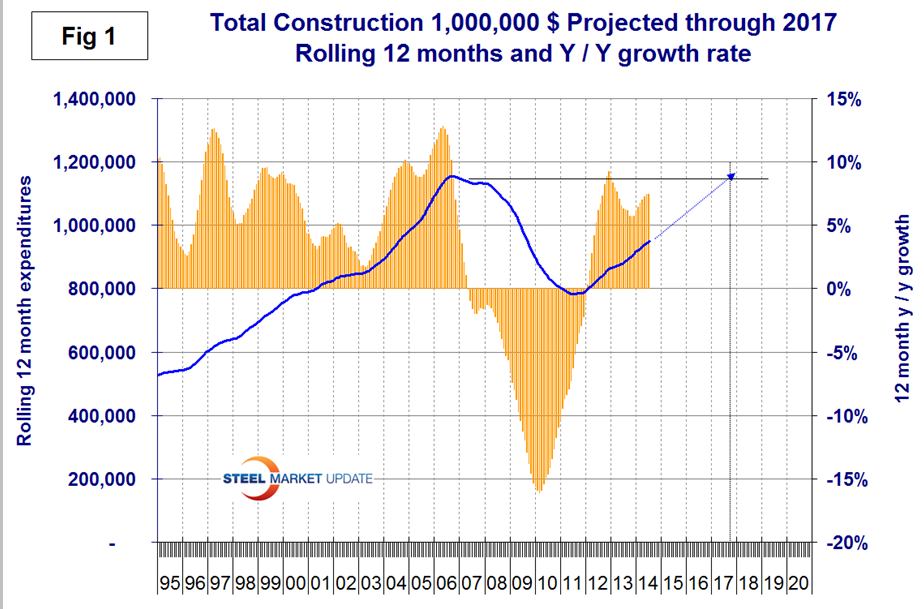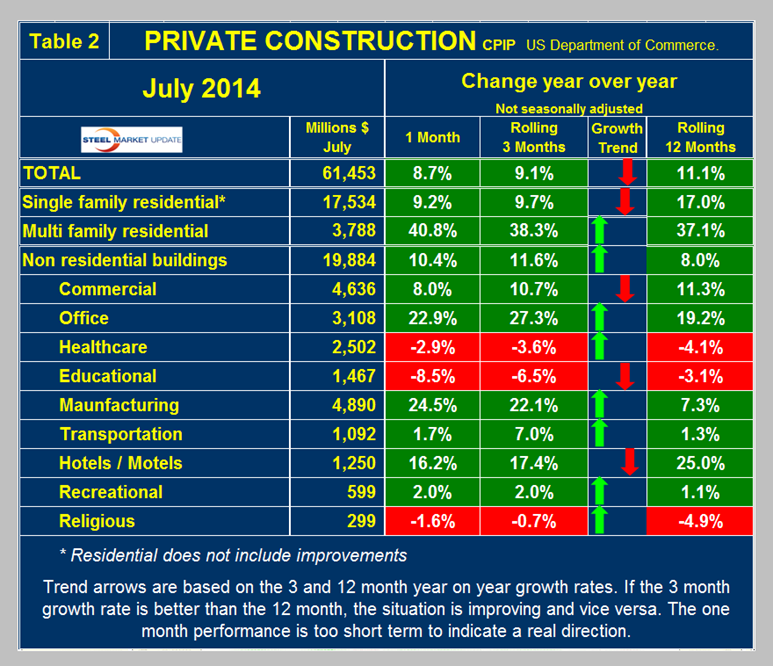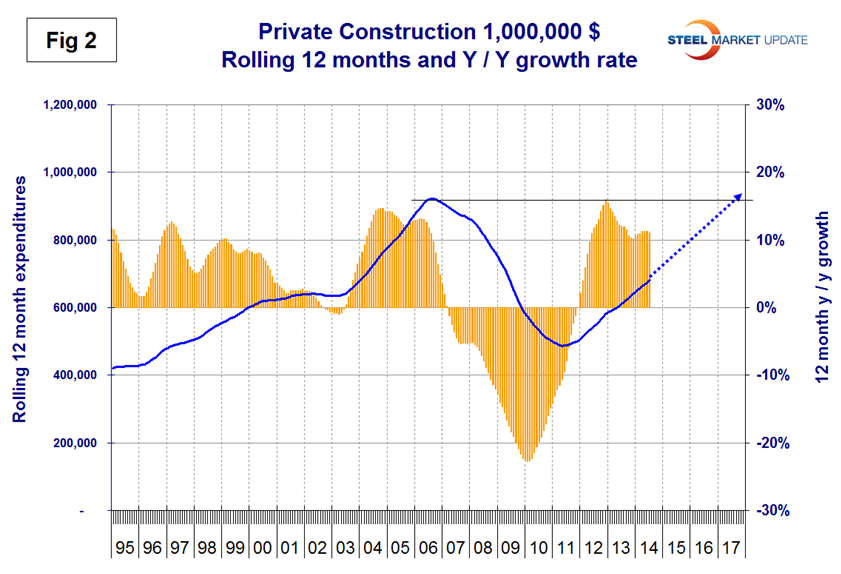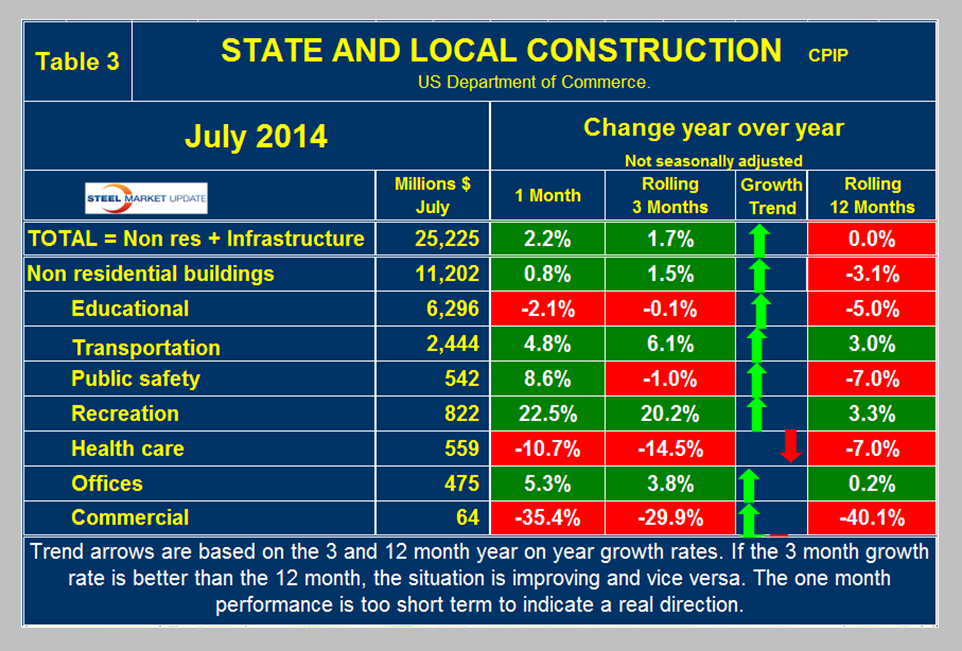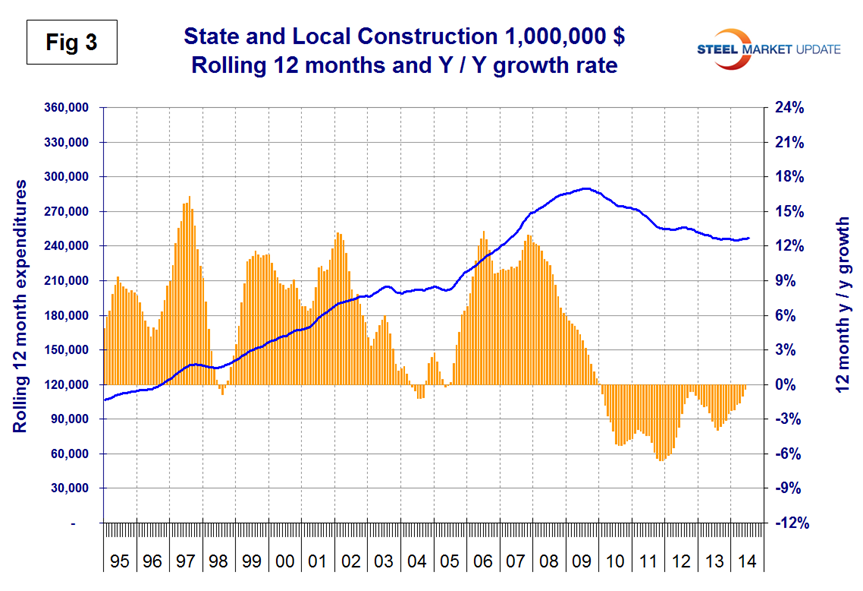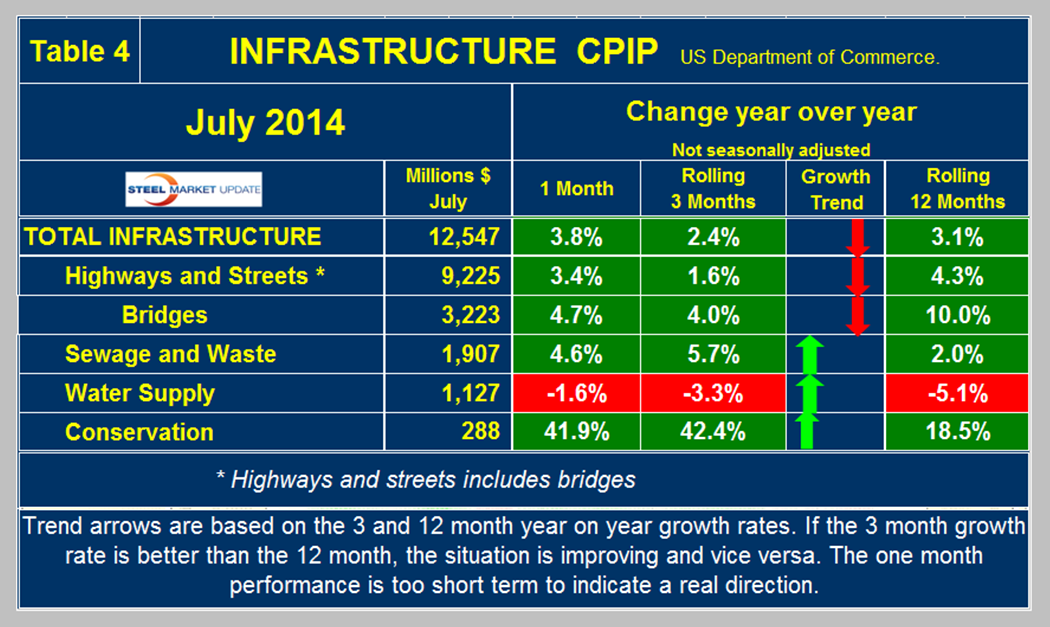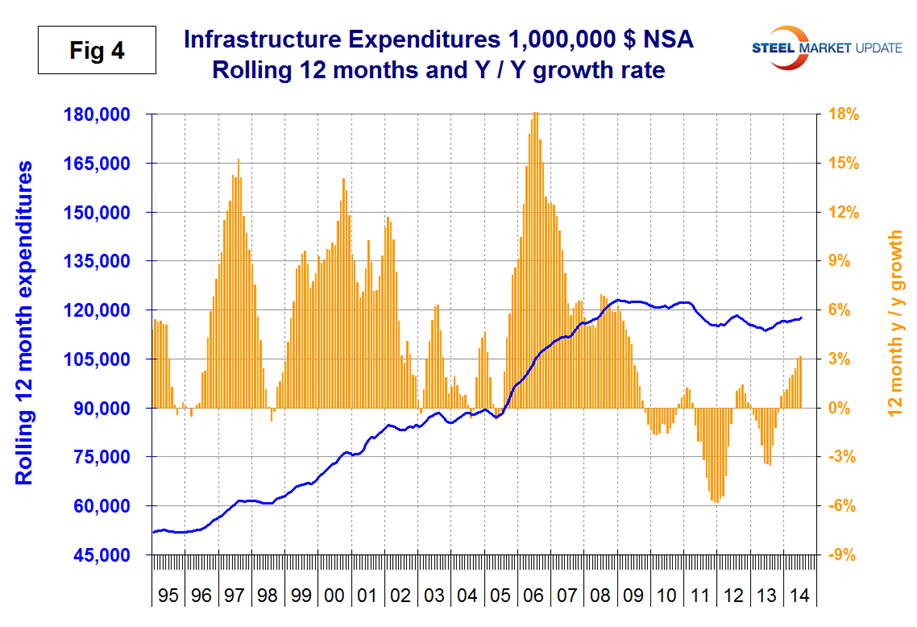Analysis

September 5, 2014
Construction Expenditures through July 2014
Written by Peter Wright
Each month the Commerce Department issues its Construction Put in Place (CPIP) data on the first working day covering activity two months earlier. July data was released on September 1st. Construction Put in Place is based on spending work as it occurs, estimated for a given month from a sample of projects. In effect the value of a project is spread out from the project’s start to its completion. Construction starts data published by the Commerce Department for residential construction and by McGraw Hill Dodge and Reed Construction for non-residential is completely different as in these cases the whole project is entered to the data base when ground is broken.
Total Construction: Data is reported on both a seasonally adjusted and non-adjusted basis. In the SMU analysis we consider only the non-seasonally adjusted data and remove seasonality by the consideration of year over year (y/y) data. We also focus on rolling 3 and 12 months to remove the noise in single month numbers. Please note that the official news release from the Commerce Department may at first glance seem to conflict with the SMU analyses because the government commentary is all about seasonally adjusted numbers.
July expenditures were $88.4 billion which breaks down to $61.53 B of private work, and $21.2 B of state and locally (S&L) funded work and $1.7 B of federally funded, (Table 1).
On a rolling three month basis total construction was up by 6.6 percent y/y and was up by 7.5 percent on a rolling 12 months y/y. This means that total construction growth is decelerating slightly since the short term growth (3 months) is less than the long term, (12 months). Note this is not a seasonal effect because our y/y analysis removes seasonality. Private work has negative momentum but state and local momentum was positive in both the June and July results. We consider three sectors within total construction. These are non-residential, residential and infrastructure. On a rolling three month basis y/y non-residential is growing at 7.8 percent and accelerating. Residential is growing at 23.2 percent and slowing. Infrastructure grew 2.4 percent y/y and decelerated in the last three months compared to the rolling 12 month number. The growth of total construction has been improving during the course of 2014 but it will be Q3 2017 before the pre recessionary peak is regained, (Figure 1). The pre-recession peak of total construction on a rolling 12 month basis was $1,145 B in 12 months through February 2007. The low point was $768 B in 12 months through May 2011. The 12 month total through the latest data of July 2014 was $950 B.
Private Construction: Private work decelerated slightly from an 11.1 percent growth rate in 12 months y/y to a 9.1 percent rate in 3 months y/y, (Table 2).
On a rolling 12 month basis the growth of private work has exceeded 10 percent for the last 23 months but at the current rate it will be late 2017 before recovery is complete, (Figure 2). Table 2 breaks down the private sector into project types. Residential buildings, both single and multi-family still have strong y/y growth but single family is slowing dramatically as multi family is accelerating. This data coincides well with the housing starts data from the Census Bureau which has single family growing at 5.7 percent rate and multifamily growing at 33.7 percent. Private non-residential buildings grew at an 11.6 percent rate in three months through July y/y with a positive momentum. Within private non-residential, only health care, educational and religious buildings had negative growth. Offices and hotels / motels continue to show surprising strength with offices accelerating and accommodation slowing.Manufacturing buildings also came on strong in the last three months.
State and Local Construction: S&L work expanded by 2.2 percent in the single month of July y/y and grew by 1.7 percent in the rolling three months through July y/y. (Table 3).
This was the third consecutive month of positive y/y growth on a rolling three months basis, the first time that has happened in four years. Overall S&L construction expenditures on a rolling 12 month basis appear to have bottomed out, (Figure 3). S&L non-residential building grew by 1.5 percent in three months through July y/y, and momentum continues to be positive. Educational buildings are about 75 percent funded by state and local governments and are by far the largest sub sector of S&L non-residential at almost $6.3 billion in July. Recreational buildings have accelerated markedly in the last four months and grew by 20.2 percent in the latest data making this the strongest sector within State and Local. Transportation terminals continue to do well. The recreational expenditures seem to fly in the face of data describing the State’s fiscal balances. Many state and local governments are far from healthy, as increased revenues have been more than offset by increased future obligations, including the need to replenish reserve and rainy-day funds and to service defined benefit liabilities, pensions and Medicaid foremost. Considering the financial weakness of many sub-national governments, it will be many years before public construction catches up to pre-recession levels.
Drilling down into the private and S&L sectors as presented in Tables 2 and 3 shows which project types should be targeted for steel sales and which should be avoided. There are some project types within S&L that are doing quite well but there are also major regional differences to be considered.
Infrastructure: expenditures have had positive growth in each of the last eleven months through July on a rolling 3 months basis with a +2.4 percent result in the latest data. The growth in three months is slower than that in 12 months meaning that momentum slowed as the industry waited for the resolution of the highway trust fund issue. Highway pavement expenditures have grown for the last eight months but slowed to only 0.3 percent in June and July, this is a sub component of Highways and Streets as is bridges which have had positive growth for the last thirteen months, (Table 4).
Water supply continued to contract through July though more slowly. There has been a surge in conservation expenditures this year but the outlays are relatively small. On a rolling 12 month basis, infrastructure expenditures are about where they were three years ago. (Figure 4).
The press release from the Commerce Department on Friday read as follows:
July 2014 Construction AT $981.3 Billion Annual Rate
The U.S. Census Bureau of the Department of Commerce announced today that construction spending during July 2014 was estimated at a seasonally adjusted annual rate of $981.3 billion, 1.8 percent (±1.6 percent) above the revised June estimate of $963.7 billion. The July figure is 8.2 percent (±2.3 percent) above the July 2013 estimate of $906.6 billion.
During the first 7 months of this year, construction spending amounted to $535.4 billion, 7.9 percent (±1.5 percent) above the $496.3 billion for the same period in 2013.
Private Construction
Spending on private construction was at a seasonally adjusted annual rate of $701.7 billion, 1.4 percent (±0.8 percent) above the revised June estimate of $692.2 billion. Residential construction was at a seasonally adjusted annual rate of $358.1 billion in July, 0.7 percent (±1.3 percent)* above the revised June estimate of $355.6 billion. Nonresidential construction was at a seasonally adjusted annual rate of $343.6 billion in July, 2.1 percent (±0.8 percent) above the revised June estimate of $336.6 billion.
Public Construction
In July, the estimated seasonally adjusted annual rate of public construction spending was $279.6 billion, 3.0 percent (±3.0 percent)* above the revised June estimate of $271.5 billion. Educational construction was at a seasonally adjusted annual rate of $63.5 billion, 1.6 percent (±4.9 percent)* above the revised June estimate of $62.5 billion. Highway construction was at a seasonally adjusted annual rate of $84.8 billion, 6.9 percent (±7.7 percent)* above the revised June estimate of $79.3 billion.



